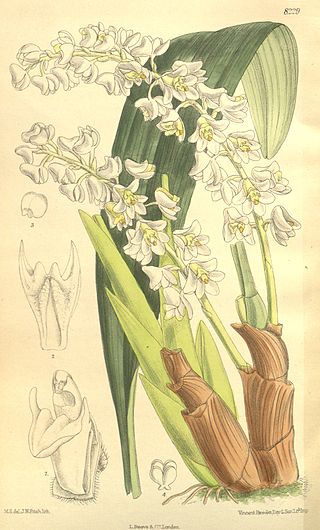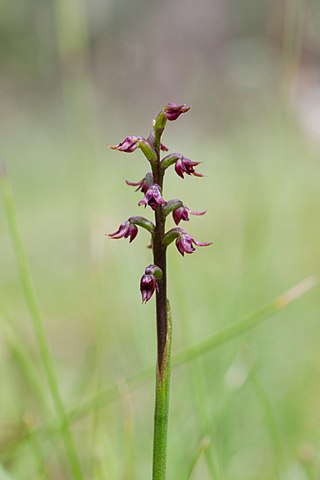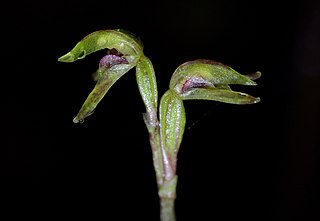
Pterostylis is a genus of about 300 species of plants in the orchid family, Orchidaceae. Commonly called greenhood orchids, they are terrestrial, deciduous, perennial, tuberous, herbs found in Australia, New Zealand, New Guinea, New Caledonia and one Indonesian island. The flowers are mostly green, sometimes with brown, reddish or white stripes, and are distinguished from other orchids by their unusual flower structures and pollination mechanism.

Rhizanthella, commonly known as underground orchids, is a genus of flowering plants in the orchid family, Orchidaceae and is endemic to Australia. All are leafless, living underground in symbiosis with mycorrhizal fungi. The inflorescence is a head of flowers held at, or just above the ground but mostly covered by soil or leaf litter and little is known about the mechanism of pollination.

Chiloglottis, commonly known as wasp orchids, ant orchids or bird orchids, is a genus of about 25 species of flowering plants in the orchid family, Orchidaceae and is found in eastern Australia and New Zealand. Wasp orchids are terrestrial herbs which grow in colonies of genetically identical plants. They usually have two leaves at the base of the plant and a single resupinate ("upside-down") flower. The labellum is more or less diamond-shaped and has calli resembling the body of a wingless female wasp.

Corybas, commonly known as helmet orchids, is a genus of about 120 species of plants in the orchid family, Orchidaceae. Helmet orchids are small, perennial, deciduous herbs and are nearly always terrestrial. They have a single leaf at their base and a single flower on a short stalk, the flower dominated by its large dorsal sepal and labellum. Species of Corybas are found in Australia, New Zealand, New Guinea, Southeast Asia, the Himalayas, southern China, many Pacific islands and a few sub-Antarctic islands.

Bryobium, commonly known as urchin orchids or 藓兰属 , is a genus of flowering plants in the family Orchidaceae. Orchids in this genus are epiphytic or lithophytic plants with large, fleshy pseudobulbs, each with up to three leathery leaves and small, often hairy flowers. These orchids are found from tropical Asia to northern Australia.

Corunastylis is a genus of about 50 species of plants in the orchid family, Orchidaceae. Commonly called midge orchids or pygmy orchids, they are terrestrial, deciduous, perennial, tuberous herbs found in Australia, New Zealand and New Caledonia. They are similar to orchids in the genus Genoplesium and have been included with them in the past.

Genoplesium commonly known as midge orchids, is a genus of about 50 species of flowering plants in the orchid family, Orchidaceae and is found in Australia, New Zealand and New Caledonia. Midge orchids are terrestrial herbs with a single leaf at the base of the plant. They are similar to orchids in the genus Prasophyllum in that plants without flowers have a hollow, onion-like leaf. The flowers are small but often scented and attractive to their insect pollinators. There is disagreement about which species belong to this genus and some taxonomists suggest that most belong in the genus Corunastylis.

Townsonia, commonly called myrtle beech orchids is a genus of two species of flowering plants from the orchid family, Orchidaceae. They form small clusters of plants with their tubers connected, each tuber with one or two leaves. The flowers are inconspicuous.

Lyperanthus, commonly known as beak orchids, is a genus of flowering plants from the orchid family, Orchidaceae, that is endemic to Australia. There are two species, one in Western Australia and the other in four eastern Australian states, distinguished by their single long, narrow, leathery leaf and dull coloured flowers which have prominent short calli on their labellum. Both form loose colonies which reproduce asexually from their tubers, and sexually using their flowers.

Orthoceras is a genus of orchids native to Australia, New Zealand and New Caledonia. Two species are known:
Corybas sulcatus, also known as the grooved helmet-orchid, is one of two helmet orchids endemic to Australia’s subantarctic Macquarie Island, and the second to be discovered. The Latin specific epithet sulcatus means "grooved”, with reference to the prominent groove in the labellum boss. It is a small, terrestrial, tuberous, herbaceous plant that forms clonal colonies. The flower is erect, mostly dark red, 25–30 mm long and 10–14 mm wide. The flowering period is November–December. It occurs on the plateau uplands of the island, growing in wet grassy seepage areas. It can be distinguished from the only other orchid on the island, Corybas dienemus, by its dark red flowers.

Diurideae is a tribe of orchid in the subfamily Orchidoideae. It contains about 40 accepted genera. As of April 2018, its division into subtribes remained unclear.

Stigmatodactylus is a genus of flowering plants from the orchid family, Orchidaceae. It has thirteen currently recognized species, native to China, Taiwan, Japan, the Himalayas, the Philippines, Malaysia, Indonesia, New Guinea and the Solomon Islands.

Thelymitra antennifera, commonly called the rabbit-eared sun orchid, lemon-scented sun orchid or vanilla orchid is a species of orchid which is native to Western Australia, South Australia and Victoria and northern parts of Tasmania.
Mark Alwin Clements (b. 1949) is an Australian botanist and orchidologist. He obtained his doctorate at the Australian National University defending his thesis entitled Reproductive Biology in relation to phylogeny of the Orchidaceae, especially the tribe Diurideae.

Rhinerrhizopsis, commonly known as freckle orchids, is a genus of three species from the orchid family, Orchidaceae. Plants in this genus are epiphytes with smooth, thin roots, fleshy or leathery leaves and a large number of small, round, short-lived flowers with a three-lobed labellum. These orchids are found in the Bismarck Archipelago, the Solomon Islands, New Guinea and tropical North Queensland, Australia.

Orthoceras novae-zeelandiae, commonly known as the New Zealand horned orchid, is a species of orchid native to New Zealand. In Māori it is called hūperei or perei.














